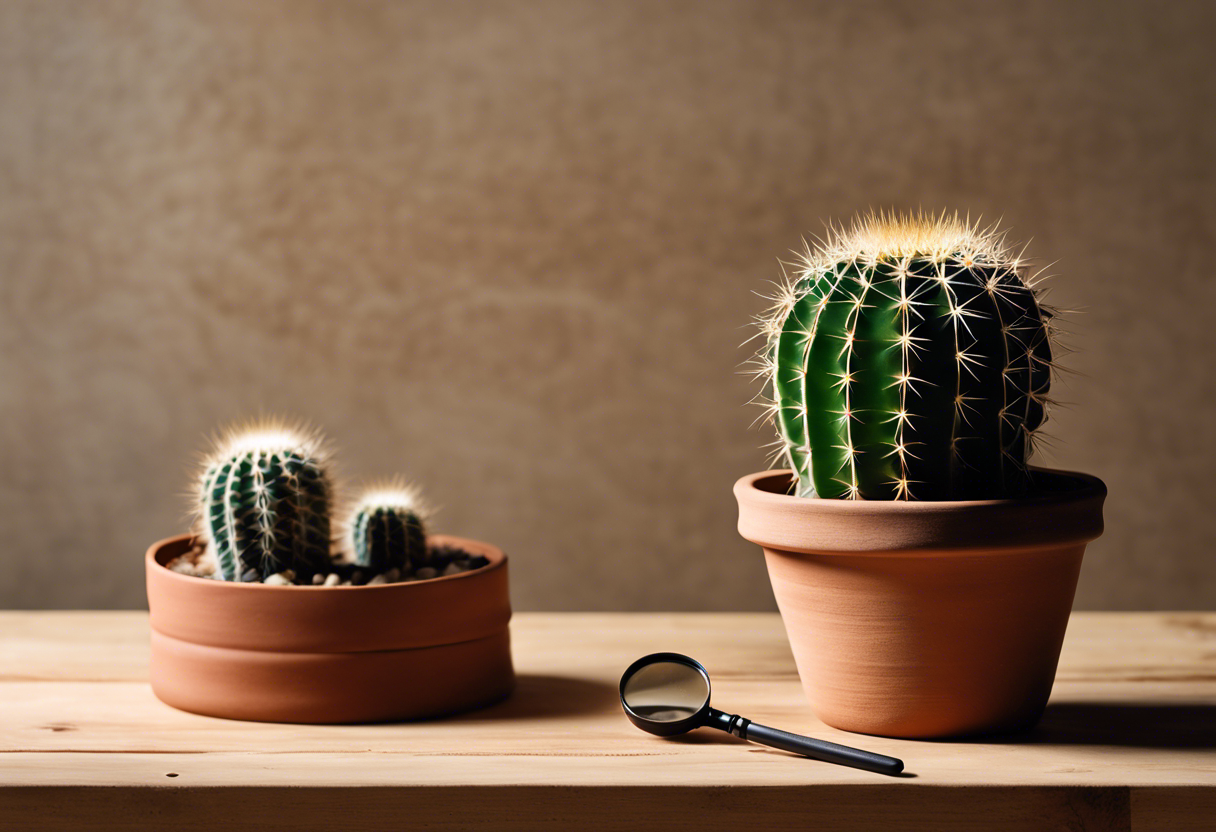Ever found yourself staring at your beloved cactus, wondering why it’s looking a bit under the weather? It’s not just you. Cacti can be tricky to care for, but don’t worry, we’ve got your back. In this guide on How to Revive a Dying Cactus, we’ll arm you with all the info you need to bring your prickly friend back from the brink.
So buckle up and prepare for some serious cactus CPR! We’re about to dive deep into the world of desert plant healthcare. Remember, every cactus has its day… and today could be yours! Keep reading about How to Revive a Dying Cactus.
Key Takeaways
- Identify the problem by checking for signs like discoloration, softness, or shrinkage.
- Overwatering is a common cause of cactus death. Let the soil dry out completely between waterings.
- Provide adequate sunlight but avoid direct harsh light which can burn the plant.
- Repotting may be necessary if root rot has set in. Use fresh, well-draining soil and a clean pot.
- Fertilize sparingly and only during growing season to prevent nutrient overload.
Understanding Cactus Health
In the world of cactus care, it’s crucial to understand the health of your prickly friend. Recognizing the signs of a sick cactus can be a game-changer, helping you diagnose problems and maintain its health. After all, nobody wants to see their beloved cactus kick the bucket!
Recognizing Signs of a Dying Cactus
Now, let’s talk about how to spot an unhealthy cactus. If your cacti are wilting or showing discoloration, that’s a red flag right there. And if you notice soft spots or shriveling? Well, it might be time for some serious cactus CPR.
But don’t panic just yet! These symptoms could also indicate an overwatered cactus, which is totally fixable. So before you start planning a cacti funeral, remember – understanding these signs is key in learning how to revive a dying cactus.
Common Causes of Cactus Death
So what sends our spiky buddies to plant heaven? Often, it’s environmental factors like overwatering or under watering – yes, both extremes can be deadly! Improper sunlight and temperature stress are other common culprits.
And let’s not forget diseases. Fungal diseases in particular can wreak havoc on your poor little plant. But hey, don’t lose hope! With proper care and attention (and maybe a little bit of luck), you can nurse your prickly pal back to health.
Diagnosing Your Cactus’ Condition
When it comes to cactus care, it’s crucial to correctly diagnose your plant’s condition. Whether it’s overwatering, underwatering, sunlight and temperature issues, or pests and diseases, each problem has unique symptoms. Understanding these cactus problems can help you figure out how to revive a dying cactus.
Checking for Overwatering or Underwatering
One of the most common mistakes in cacti care is incorrect watering. An overwatered cactus may show symptoms like yellowing or softening of the stem. On the other hand, an underwatered one might have shriveled skin or discoloration.
Both conditions can severely affect your cacti’s health. Overwatering often leads to root rot, while underwatering can cause dehydration. So remember folks, when it comes to watering cacti properly, balance is key!
Identifying Sunlight and Temperature Issues
Sunlight and temperature play a significant role in your cacti’s wellbeing too. If your plant isn’t getting enough light, it might start growing towards the light source (a condition known as etiolation). Too much sunlight can cause sunburns on your cacti – yep, they get sunburnt too!
Temperature-wise, most cacti prefer warmer climates but they don’t do well with extreme heat or cold. Cold damage usually shows up as blackened areas on the plant. So keep an eye on those temperature requirements for healthy cacti.
Detecting Pests and Diseases
Last but not least are pests and diseases – every plant parent’s nightmare! Common culprits include mealybugs and scale insects which leave cotton-like substances on your plants.
Diseases like fungal infections can also wreak havoc on your beloved succulents causing spots or moldy patches. These issues can be harmful, even fatal to your cacti if not treated promptly. So keep a keen eye on your prickly pals for any signs of common diseases affecting succulents or pests.
Reviving Techniques for a Dying Cactus
When it comes to how to revive a dying cactus, there’s no one-size-fits-all approach. You gotta be like a plant detective, using your cactus care tips and reviving dying plants knowledge to crack the case.
Adjusting Watering Practices
First off, let’s talk watering. Overwatering or underwatering your cacti can send them straight to plant heaven. It’s all about balance, folks! If you’re seeing signs of an overwatered cactus, like yellowing or mushy stems, cut back on the H2O pronto.
On the flip side, if your cacti are shriveling up faster than a raisin in the sun, they might be thirsty. Look out for underwatered cactus symptoms like wrinkled skin and droopy arms. The best time to water cacti is when their soil is bone dry.
Modifying Light and Temperature Conditions
Next up, we got light and temperature conditions. Your indoor or outdoor cacti need just the right amount of sunshine and warmth to thrive. Too much or too little light can lead to some serious problems.
If your green buddies aren’t getting enough rays (effects of low light on cacti), they might start stretching out towards the light source (a condition known as etiolation). On the other hand, too much direct sunlight can cause sunburns (yes, plants get sunburnt too!).
Temperature-wise, most types of cacti prefer temperatures between 65-85°F during their growing season. Watch out for signs of heat stress if temperatures rise above this range (impact of high temperatures on cacti).
Treating Pests and Diseases
Finally, let’s tackle pests and diseases – every plant parent’s worst nightmare! Common pests in cacti include mealybugs, spider mites, and scale insects. If you spot these critters, it’s time to bring out the big guns (aka insecticidal soap).
Diseases can also wreak havoc on your prickly pals. Fungal and bacterial infections are common culprits. If you notice black or brown spots on your cactus, it might be diseased. Don’t panic though! With the right treatment for diseased cacti, you can nurse them back to health.
Remember folks, prevention is better than cure! Keep those pests at bay by maintaining good indoor plant care practices like regular cleaning and proper watering.
Preventive Measures to Keep Your Cactus Healthy
In the journey of how to revive a dying cactus, let’s not forget the importance of preventive measures. A stitch in time, as they say, saves nine. So, let’s dive into some cactus care tips that are crucial for healthy cactus maintenance.
Ideal Watering Practices for a Cactus
Watering your cacti right is like hitting the bullseye in darts. It’s all about precision and timing. The golden rule? Don’t overwater! Overwatering is like feeding them junk food – it’s just not healthy.
So, how often should you water your cacti? Well, it depends on the season and climate. In hot and dry conditions, watering once a week should suffice. But in cooler climates or seasons, you might want to cut back to once every two weeks or even once a month.
The best time to water your cacti? Early morning or late evening when temperatures are cooler. This allows the water to soak into the soil without evaporating quickly due to heat.
Optimal Sunlight and Temperature Conditions
Sunlight is like spinach to Popeye for your cacti – they need it for strength and growth! But remember, too much of anything can be harmful. Aim for a balance between sunlight and shade.
Indoor cacti prefer bright but indirect light while outdoor ones can handle more direct sunlight. However, extreme heat can cause sunburn (yes, plants get sunburned too!). So during scorching summer days, consider providing some shade.
Temperature-wise, most cacti prefer temperatures between 65°F and 85°F (18°C – 29°C). They can tolerate colder temps down to about 50°F (10°C), but anything below that could lead them towards an icy death!
Preventing Pests and Diseases
Pests and diseases are like the villains in a superhero movie for your cacti. They’re the bad guys you need to keep at bay.
Common pests that can harm your cacti include mealybugs, scale insects, and spider mites. To prevent these baddies from attacking, regularly check your plants for any signs of infestation.
As for diseases, overwatering can lead to root rot – a common disease in cacti. So again, be careful with watering! If you notice your cactus looking sickly or showing signs of disease, don’t hesitate to seek professional help. Remember, it’s always better to be safe than sorry!
To Wrap Up
In the grand scheme of things, reviving a dying cactus isn’t rocket science. It’s more like playing detective with a prickly friend who can’t spill the beans about what’s bugging them. Just remember, proper sunlight, watering habits and pest control are your best tools in this mission.
So, don’t throw in the towel just yet! With our guide on How to Revive a Dying Cactus, you’ll have your spiky sidekick back on its feet in no time. And remember – every cactus deserves a second chance!





